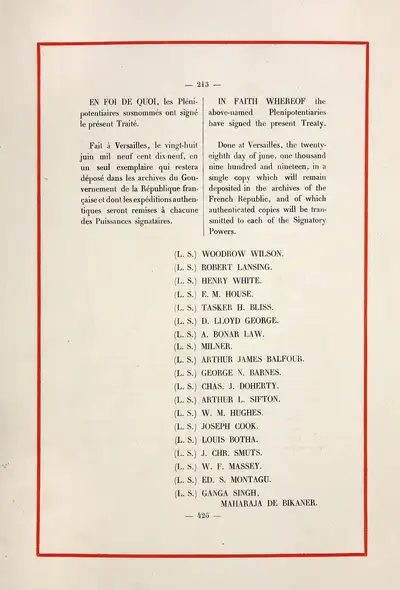Record revealed
The Treaty of Versailles
The Treaty of Versailles officially ended the First World War and set out the terms and conditions for peace, and determined the course of the 20th century. The National Archives holds the authenticated British copy.
Images
Image 1 of 5

The front cover of the authenticated British copy of the Treaty of Versailles.
Image 2 of 5

The opening paragraphs of the treaty.
Transcript
The United States of America, The British Empire, France, Italy and Japan,
These Powers being described in the present Treaty as the Principal Allied and Associated Powers,
Belgium, Bolivia, Brazil, China, Cuba, Ecuador, Greece, Guatemala, Haiti, The Hedjaz, Honduras, Liberia, Nicaragua, Panama, Peru, Poland, Portugal, Roumania, The Serb-Croat-Slovene State, Siam, Czecho-Slovakia and Uruguay,
These Powers constituting with the Principal Powers mentioned above the Allied and Associated Powers,
Of the one part;
And Germany,
Of the other part;
Bearing in mind that on the request of the Imperial German Government an Armistice was granted on November 11, 1918, to Germany by the Principal Allied and Associated Powers in order that a Treaty of Peace might be concluded with her, and
The Allied and Associated Powers being equally desirous that the war in which they were successively involved directly or indirectly and which originated in the declaration of war by Austria- Hungary on July 28, 1914, against Serbia, the declaration of war by Germany against Russia...
Image 3 of 5

The treaty's signatories.
Transcript
In faith whereof the above-named Plenipotentiaries have signed the present Treaty.
Done at Versailles, the twenty-eighth day of june, one thousand nine hundred and nineteen, in a single copy which will remain deposited in the archives of the French Republic, and of which authenticated copies will be transmitted to each of the Signatory Powers.
Woodrow Wilson
Robert Lansing
Henry White
E. M. House
Tasker H. Bliss
D. Lloyd George
A. Bonar Law
Milner
Arthur James Balfour
George N. Barnes
Chas. J. Doherty
Arthur L. Sifton
W. M. Hughes
Joseph Cook
Louis Botha
J. CHR. Smuts
W. F. Massey
Ed. S. Montagu
Ganga Singh, Maharaja De Bikaner
Image 4 of 5

The treaty contains large fold-out maps marking different relevant territories. Under the terms of the treaty, the territory of the Saar Basin in south-west Germany was to be occupied and governed by the United Kingdom and France for 15 years.
Image 5 of 5

The copy of the treaty at The National Archives. The left pages are in French and on the right is the same content in English.
Why this record matters
- Date
- 28 June 1919
- Catalogue reference
- FO 93/36/76
The First World War was said to be the war to end all wars, and the embodiment of this was The Treaty of Versailles. Signed at the conclusion of the Paris Peace Conference, on 28 June 1919, it was designed to establish peace, prevent war, and to ensure Germany would never be a military power again. It also officially ended the First World War five years to the day after the spark that started it, the assassination of Franz Ferdinand.
Only one signed copy of the treaty was made, which was deposited in the archives of the French Republic. Authenticated copies were provided to the signatory powers. The original is not known to have survived.
The treaty was put together by the victorious Allied forces of the First World War, but the overarching decisions were made by the Council of Four, composed of leaders of the ‘big three’ powers, David Lloyd George of Great Britain, Georges Clemenceau of France, and Woodrow Wilson of America, as well as the Italian Premier, Vittorio Orlando. Germany was not allowed to participate in negotiations.
The conference took six months with ten committees established to come up with the principal terms and issues to be included. The final agreement contained 440 articles in 15 parts. The treaty required a much reduced and demilitarised Germany to pay an initial sum of 200,000,000 gold marks, as well as making reparations and restitution in terms of cash, livestock and mineral resources. Germany was also made to accept responsibility for the war and the damage it caused. Another key condition was establishing the League of Nations – a precursor to the United Nations – an intergovernmental body to maintain peace around the world through collective security.
The treaty was badly received in Germany and its impacts were quickly felt. The uncompromising terms undermined the legitimacy of the newly elected Weimar government who had ratified it. This opened it to attack from the extreme right and left. The denunciation of the treaty was one of the platforms that gave the Nazi Party credibility with mainstream voters in the early 1920s and early 1930s.
With the outbreak of the Second World War, it became clear the treaty had failed in its aims. Worse still were the arguments that the harsh treatment of Germany was a key cause. However, its attempt to create a platform for world peace has had a lasting impact.
The British copy is comprised of 428 pages and arrived shortly after the conference. It is about 45cm long, 33cm wide, and 5cm thick. The only signature is that of the French Foreign Secretary Stephen Pichon, who signed it as a true copy. On arrival, it was bound using the Foreign Office's usual red leather. It was transferred to The National Archives in the 1960s.
